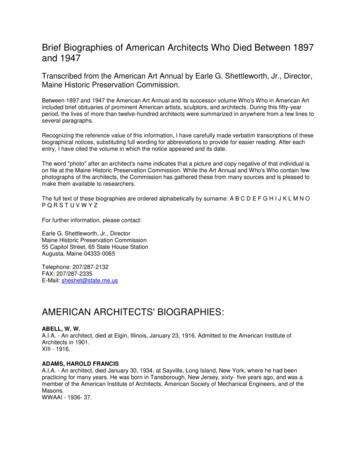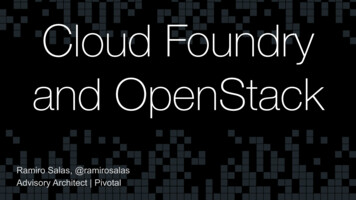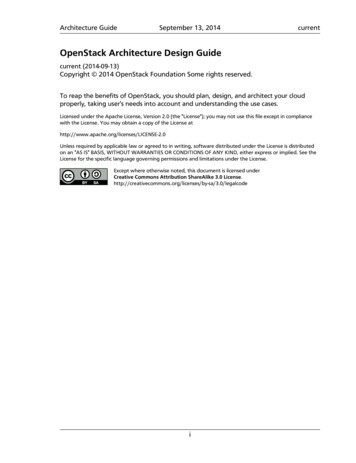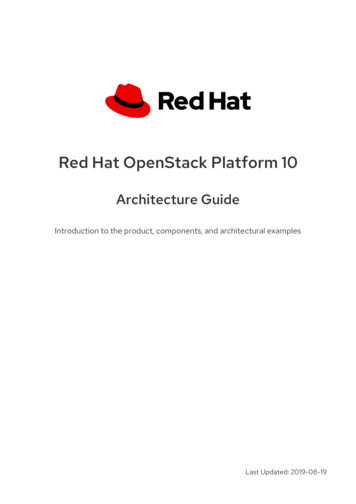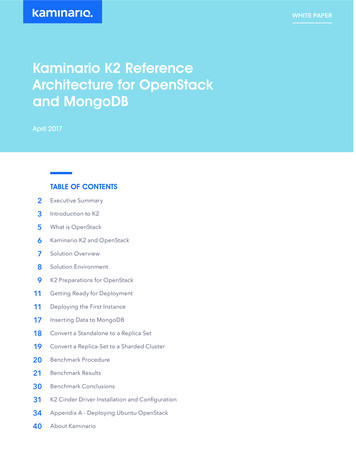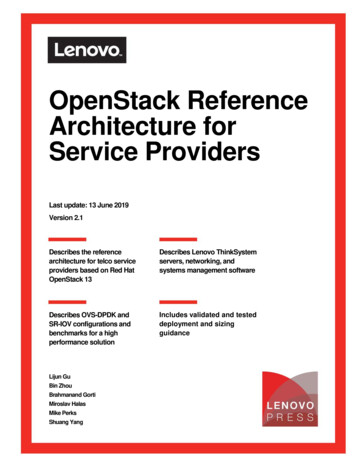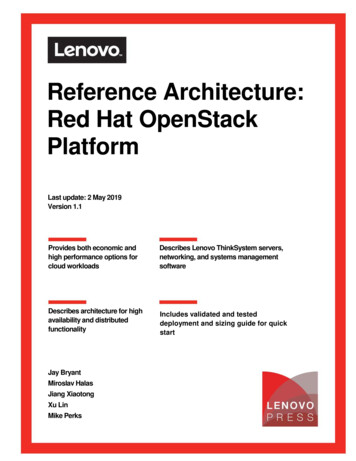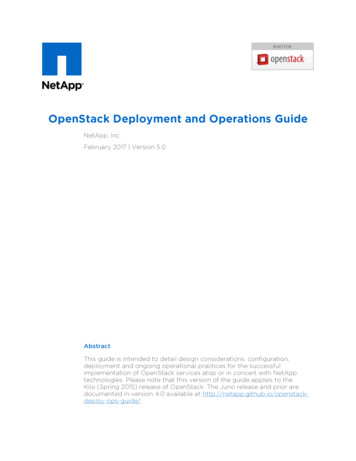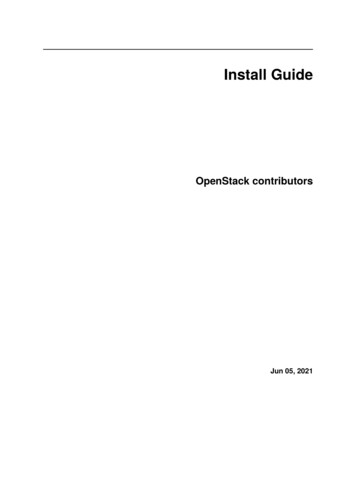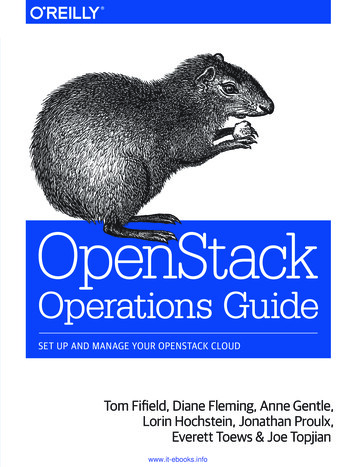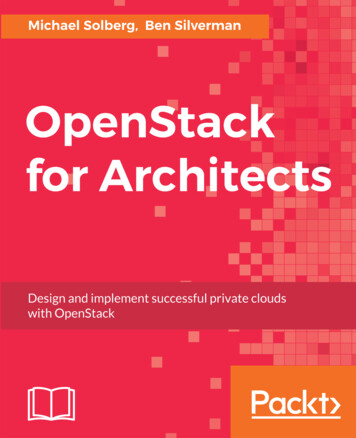
Transcription
OpenStack for ArchitectsDesign and implement successful private clouds withOpenStackMichael SolbergBen SilvermanBIRMINGHAM - MUMBAI
OpenStack for ArchitectsCopyright 2017 Packt PublishingAll rights reserved. No part of this book may be reproduced, stored in a retrieval system, ortransmitted in any form or by any means, without the prior written permission of thepublisher, except in the case of brief quotations embedded in critical articles or reviews.Every effort has been made in the preparation of this book to ensure the accuracy of theinformation presented. However, the information contained in this book is sold withoutwarranty, either express or implied. Neither the authors, nor Packt Publishing, and itsdealers and distributors will be held liable for any damages caused or alleged to be causeddirectly or indirectly by this book.Packt Publishing has endeavored to provide trademark information about all of thecompanies and products mentioned in this book by the appropriate use of capitals.However, Packt Publishing cannot guarantee the accuracy of this information.First published: February 2017Production reference: 1310117Published by Packt Publishing Ltd.Livery Place35 Livery StreetBirminghamB3 2PB, UK.ISBN 978-1-78439-510-0www.packtpub.com
CreditsAuthorsMichael SolbergBen SilvermanCopy EditorTom JacobReviewerLauren MalhoitProject CoordinatorJudie JoseCommissioning EditorVeena PagareProofreaderSafis EditingAcquisition EditorMeeta RajaniIndexerFrancy PuthiryContent Development EditorsRadhika AtitkarSanjeet RaoGraphicsKirk D'PenhaTechnical EditorNidhisha ShettyProduction CoordinatorShantanu Zagade
About the AuthorsMichael Solberg, as a chief architect, is responsible for helping Red Hat customers achievetheir key business transformation initiatives through open source architectures andtechnologies. He regularly advises a range of Fortune 100 companies in financial services,healthcare, retail, and transportation verticals on topics such as cloud computing, big data,high-performance computing, and enterprise middleware. At Red Hat since 2008, Michaelhas led a number of successful initiatives to assist strategic customers adopt newvirtualization, systems management, and engineering practices. His previous experienceincludes building web hosting infrastructure. He is also an avid supporter of the OpenStackproject. Michael holds a Bachelor's degree from the University of Georgia and is a regularspeaker at industry events.I would like to thank Kyle Gonzales and Brent Holden for their early work on the project.Huge thanks to Joseph Scalia for reviewing the book and continually encouraging me towork on the project.Ben Silverman, as the Principal Cloud Architect for OnX Enterprise Solutions, isresponsible for providing strategic and tactical cloud leadership to OnX’s customers.Previously, Ben was a Senior Cloud Architect at Mirantis, where he developed cloudsolutions for many Fortune 100 companies. Ben has been involved with OpenStack since theHavana release and is an active technical contributor. Prior to working for Mirantis, Benwas the Lead Technical Architect at American Express, where he built one of the largestfinancial services OpenStack clouds at that time. Ben is an exuberant OpenStack evangelistwho is often seen speaking at industry events and conventions about OpenStack adoption,scale challenges, and cloud operations. In his limited spare time, Ben and a few others havetaken on the task of re-writing all of the OpenStack architecture and operations guides thatare currently available on the OpenStack Foundation website. Ben has a Master’s degree inInformation Management from Arizona State University and lives in Phoenix, AZ.I would like to thank my wife, Jennifer, and my two sons, Jason and Brayden, for all of thelove and encouragement, as well as the necessary interruptions to make me smile with ahug, a kiss, a silly comment, or a new drawing for daddy’s desk.
www.PacktPub.comFor support files and downloads related to your book, please visit www.PacktPub.com.Did you know that Packt offers eBook versions of every book published, with PDF andePub files available? You can upgrade to the eBook version at www.PacktPub.com and as aprint book customer, you are entitled to a discount on the eBook copy. Get in touch with usat service@packtpub.com for more details.At www.PacktPub.com, you can also read a collection of free technical articles, sign up for arange of free newsletters and receive exclusive discounts and offers on Packt books andeBooks.https://www.packtpub.com/maptGet the most in-demand software skills with Mapt. Mapt gives you full access to all Packtbooks and video courses, as well as industry-leading tools to help you plan your personaldevelopment and advance your career.Why subscribe?Fully searchable across every book published by PacktCopy and paste, print, and bookmark contentOn demand and accessible via a web browser
Customer FeedbackThank you for purchasing this Packt book. We take our commitment to improving ourcontent and products to meet your needs seriously—that's why your feedback is sovaluable. Whatever your feelings about your purchase, please consider leaving a review onthis book's Amazon page. Not only will this help us, more importantly it will also helpothers in the community to make an informed decision about the resources that they investin to learn. You can also review for us on a regular basis by joining our reviewers' club. Ifyou're interested in joining, or would like to learn more about the benefits we offer,please contact us: customerreviews@packtpub.com.
Table of ContentsPrefaceChapter 1: Introducing OpenStackWhat is OpenStack?OpenStack is an APIOpenStack – an open source software projectOpenStack – a private cloud platformOpenStack componentsComputeObject StorageBlock storageNetworkCommon OpenStack use casesPublic hostingHigh-performance computeRapid application developmentNetwork Function VirtualizationDrafting an initial deployment planThe role of the ArchitectThe design documentThe deployment planYour first OpenStack deploymentWriting the initial deployment planHardwareNetwork addressingConfiguration notesRequirementsInstalling OpenStackInstallation instructionsVerifying the installationNext stepsSummaryReferencesChapter 2: Architecting the CloudPicking an OpenStack distributionRunning from the 02021232324252626
Community distributionsCommercially supported distributionsCompute hardware considerationsHypervisor selectionSizing the hardware to match the workloadConsiderations for performance-intensive workloadsNetwork designProviding network segmentationSDNPhysical network designStorage designEphemeral storageBlock storageObject storageExpanding the initial deploymentUpdating the design documentCloud controllerCompute nodeManagement networkProvider networkTenant networkUpdating the deployment planInstalling OpenStack with the new configurationSummaryReferencesChapter 3: Planning for Failure (and Success)Building a highly available control planeAbout failure and successHigh availability patterns for the control planeActive/Passive service configurationActive/Active service configurationOpenStack service specificsOpenStack web servicesDatabase servicesThe message busCompute, storage, and network agentsRegions, cells, and availability zonesRegionsCellsAvailability zones[ ii 6474848505152525253535455555657
Updating the design documentPlanning the physical architectureUpdating the physical architecture designImplementing H/A in the lab deploymentProvisioning a second controllerInstalling the Pacemaker resource managerInstalling and configuring HAProxyAdditional API service configurationSummaryReferencesChapter 4: Building the Deployment PipelineDealing with Infrastructure as a SoftwareEating the elephantWriting the tests firstAlways be deployingUsing configuration management for deploymentUsing the community modulesAssigning rolesChoosing a starting pointTest infrastructureTypes of testingWriting the testsRunning the testsPutting the pipeline togetherSetting up the CI serverInstalling GitInstalling a Puppet masterInstalling JenkinsCreating the composition layerStarting our Puppet modulesDefining the first role and profileRunning the first buildWriting the testsAssigning the first role to a systemInstalling KeystoneFully automating the pipelineSummaryReferencesChapter 5: Building to 777777878808184858688929495979899100[ iii ]
Expected outcomes of this chapterLogging, monitoring, and alertingLoggingMonitoringWhat to monitorMonitoring practicesMonitoring availabilityMonitoring performanceMonitoring resource usageAlertingActive monitoringServicesProcessesHA control clusterCapacity planningPlanning your cityTracking usage and analyzing growthFlavor sizing and compute server hardware selectionBackups and recoveryInfrastructure backup architectureBackup strategies – what to backupWorkload backup architecturePlanning for disaster recoverySummaryReferencesChapter 6: Integrating the 113114114117122122122124124127127129IdM integrationAuthentication and authorization in OpenStackConfiguring Keystone with split assignment and identityProvisioning workflowsThe Horizon user interfaceUsing the REST APIsProvisioning with templatesMetering and billingListening to OpenStackUsing the notification subsystemConsuming events from CeilometerReading meters in CeilometerUpdating the design documentWriting requirementsTesting requirements[ iv ]130130131133133135139141142143145146148148151
SummaryReferences152153Chapter 7: Securing the Cloud154Security zones within OpenStackSoftware vulnerabilitiesInstance software security and patchingInfrastructure host security and patchingPatching OpenStack codePatching the operating er 8: Conclusion183Red Hat Enterprise Linux and CentOSCanonical Ubuntu based operating systemsSoftware repository managementHardening hypervisorsStandard Linux hardening practices and hypervisorsSELinux and AppArmorsVirtSELinux and sVirt in actionSSL and certificate managementAssessing riskBest practices for endpoint securityExamplesAuditing OpenStackCADF detailsUsing CADF with OpenStackLog aggregation and analysisEmerging trends in OpenStackMoving up the stackThe impact of containersBuilding the roadmapIntroducing new featuresReleasing new ndex188[v]
PrefaceThis guide leads you through each of the major decision points that you'll face as youarchitect an OpenStack private cloud for your organization. At each point, we offer youadvice based on years of experience designing and leading successful OpenStack projects ina wide range of industries. Each chapter also includes lab materials that give you a chanceto install and configure the technologies used to build production-quality OpenStackclouds. Most importantly, we focus on ensuring that your OpenStack project meets theneeds of your organization, which will guarantee a successful roll-out.What this book coversChapter 1, Introducing OpenStack, helps you familiarize yourself with the components ofOpenStack.Chapter 2, Architecting the Cloud, explains the software, hardware, network, and storageselection options for OpenStack.Chapter 3, Planning for Failure (and Success), covers techniques of increasing the scalabilityand availability of the cloud.Chapter 4, Building the Deployment Pipeline, shows how to use the concepts of DevOps tocreate a continuously integrated and delivered OpenStack deployment.Chapter 5, Building to Operate, explains how to architect a private cloud that is optimizedfor operations.Chapter 6, Integrating the Platform, reveals three different integration patterns forOpenStack clouds.Chapter 7, Securing the Cloud, introduces how to design a private cloud that is secure fromthe beginning.Chapter 8, Conclusion, covers creating a compelling road map for the future ofInfrastructure as a Service in your organization.
PrefaceWhat you need for this bookAll of the software used in the examples in this book is available at no cost on the Internet.Links are provided for each of the projects used. Many of the lab exercises require access tophysical hardware. We recommend having at least four and up to 12 physical serversavailable for deploying OpenStack.Who this book is forThis book is written especially for those who will design OpenStack clouds and lead theirimplementation. These people are typically cloud architects, but may also be in productmanagement, systems engineering, or enterprise architecture.ConventionsIn this book, you will find a number of text styles that distinguish between different kindsof information. Here are some examples of these styles and an explanation of their meaning.Code words in text, database table names, folder names, filenames, file extensions,pathnames, dummy URLs, user input, and Twitter handles are shown as follows: "Thekeystonerc admin file can be used to authenticate an administrative user and thekeystonerc demo file can be used to authenticate a non-privileged user."A block of code is set as follows:exportexportexportexportexportOS USERNAME demoOS TENANT NAME demoOS PASSWORD random string OS AUTH URL http://192.168.0.10:5000/v2.0/PS1 '[\u@\h \W(keystone demo)]\ 'When we wish to draw your attention to a particular part of a code block, the relevant linesor items are set in bold:exportexportexportexportexportOS USERNAME demoOS TENANT NAME demoOS PASSWORD random string OS AUTH URL http://192.168.0.10:5000/v2.0/PS1 '[\u@\h \W(keystone demo)]\ '[2]
PrefaceAny command-line input or output is written as follows:# yum install -y openstack-packstackNew terms and important words are shown in bold. Words that y
Ben is an exuberant OpenStack evangelist who is often seen speaking at industry events and conventions about OpenStack adoption, scale challenges, and cloud operations. In his limited spare time, Ben and a few others have taken on the task of re-writing all of the OpenStack architecture and operations guides that

